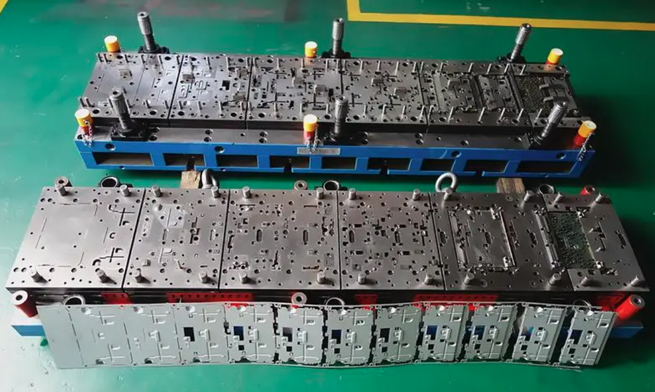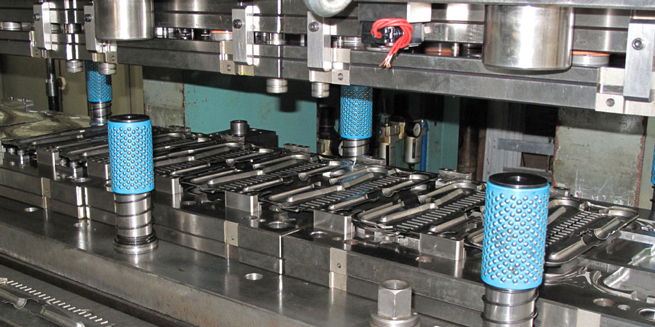
Progressive die refers to a cold Stamping die in which a press machine uses strip Stamping raw materials to complete multiple stamping processes simultaneously on a set of molds using several different workstations during a single stamping stroke. The mold completes each stamping process and the strip moves at a fixed distance until the product is completed.
(1) A progressive die can complete multiple processes such as punching, Bending, forming, and deep drawing. The press can punch one workpiece or several pieces per stroke, thus having higher labor productivity than compound die.
(2) The use of progressive die stamping can reduce the number of equipment, molds, and workshop area, saving the transportation and storage of semi-finished products.
(3) The progressive mold uses coil or strip materials, and it is easy to achieve automation in feeding, discharging, and stacking. During the stamping process of automated progressive molds, workers do not need to enter hazardous areas, ensuring safe operation.
(4) The various processes of the progressive mold are dispersed in various workstations, and there is no problem with the "minimum wall thickness" of the compound mold, so the mold has higher strength and longer lifespan.
(5) The progressive mold has complex structure, high manufacturing accuracy, long cycle, high cost, and difficult maintenance.
(6) Due to the fact that each process is completed at different workstations, the accumulated positioning error will affect the accuracy of the workpiece, so the accuracy of the workpiece produced by the progressive mold is not high.

Whether a stamping part adopts a multi-station progressive die should consider the following aspects:
(1) Design, production, and maintenance of progressive molds
The structure of a multi-station progressive mold is quite complex, and the manufacturing accuracy is much higher than the general mold requirements. After each batch production, it must undergo a maintenance, blade grinding, and trial punching before being put into storage for use. Some small protruding molds and inserts must be replaced promptly after wear or damage. When grinding the edges of convex and concave molds with multi-station progressive molds for Bending, drawing, and forming, the relative height of other parts must be corrected at the same time. The height of the convex and concave molds of multi-station progressive molds for bending, deep drawing, and forming is often different, so the relative difference required by the original design must be maintained after edge grinding. It is necessary to have maintenance workers with a certain level of technical skills and necessary specialized equipment with relatively precision.
(2) Applicable Press
The press used in the progressive mold should have sufficient strength, stiffness, power, accuracy, a large worktable, and a reliable braking system. The stroke of the punch should not be too large to ensure that the guide system of the progressive mold base does not detach during operation. Generally, work should be carried out below 80% of the nominal pressure of the press. A detection mechanism for bar feeding faults should be set up in the multi-station progressive mold. After the detection mechanism sends a signal, the braking system must be able to immediately stop the press to avoid damaging the mold or machine tool.
(3) Good processed materials
During the progressive die stamping process, intermediate annealing is not allowed, which makes it difficult to increase lubrication during processing. Therefore, it is required that the mechanical properties of the stamping materials must be relatively stable, and each batch of materials entering the factory must be tested and inspected according to regulations; progressive die stamping has high requirements for the width and thickness tolerances of the strip material used, as well as the flatness of the material edge, as they will directly affect the stamping effect and the feeding of the strip material.
(4) Stamped parts should be suitable for multi-station progressive die stamping
1. The output and batch size of the processed parts should be large enough.
2. Multi-station progressive molds have lower material properties than other molds.
3. The feeding accuracy and cumulative error between each step should not reduce the accuracy of the parts.
4. For parts with complex shapes that are difficult to locate after stamping, using a multi-station progressive mold is the most ideal.

